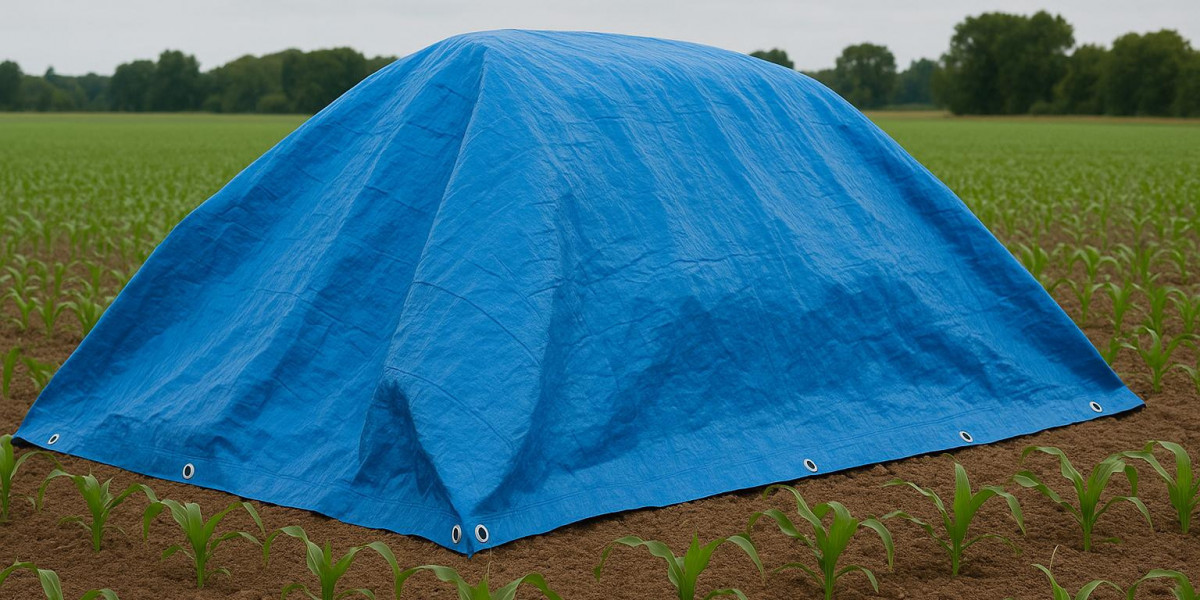Tarpaulin might not be the most glamorous item on your farm, but when the skies open up or the sun blazes down, it becomes one of the most critical. Whether you're storing feed, protecting equipment, covering harvests, or building temporary shelters, choosing the right tarpaulin coverage isn’t just about size—it’s about understanding what your farm truly demands.
Farmers often overestimate or underestimate the amount of tarpaulin they will need. This results in waste, inadequate coverage, or excessive expenditure on materials that are eventually stored in a shed. It takes more than just a tape measure to determine the actual amount of covering you need. Understanding your processes, environment, usage patterns, and material quality is the first step.
This book can help you save money, time, and a great deal of frustration by explaining how to determine and select the appropriate tarpaulin coverage for various needs on your farm.
Why Sizing Matters More Than You Think
The size of a tarpaulin doesn’t just dictate how much it can cover—it also affects its performance in real-world farm conditions. A tarp that’s too small will pull tight and tear under tension. A tarp that’s too big can trap wind, flap violently, and deteriorate faster.
Here’s what to consider:
Surface Area: What exactly are you covering—cattle feed, a tractor, a silage pit, or harvested produce?
Coverage Style: Will the tarpaulin lie flat on top, or will it wrap around sides? Side coverage can easily double the material needed.
Fixing Points: Are there anchor points or structures to tie the tarp securely? Loose ends reduce longevity.
For many farm applications, especially large outdoor storage, farmers prefer to Buy Tarpaulin Sheets Online because it offers custom sizing and GSM options tailored to agricultural use—not just generic plastic covers. This allows for more accurate purchases based on need, rather than trial and error.
Common Farm Uses and Coverage Requirements
Let’s explore how much coverage you really need based on specific farm use cases. These aren’t just estimates—they’re field-tested guidelines.
Covering Stored Crops or Harvests
A tarp that extends at least two to three feet beyond the pile on all sides is required for post-harvest protection of grains, vegetables, or pulses. This stops runoff seepage and permits safe tucking.
Small harvest (up to 1 ton): 12 ft x 15 ft
Medium harvest (2–3 tons): 15 ft x 18 ft
Large stack or bulk heap: 18 ft x 24 ft or larger
Also factor in local wind speeds and rainfall intensity. A flat tarp may work in calm conditions, but in windy areas, side coverage is essential.
Covering Hay and Straw Bales
Hay that is stacked requires complete top and side coverage in addition to air circulation. Tarps should be permeable, extend to the ground, and be left open occasionally to prevent mold growth.
Single row (round bales): 14 ft x 24 ft
Multiple stacks: 24 ft x 36 ft or modular sets
Baling guides often recommend storing hay on raised wooden pallets to avoid moisture wicking from the ground—even with tarp coverage.
Machinery and Equipment Storage
Tractors, tillers, and implements need tight-fitting tarps that won't flap or shift. Measure length + width + 1–2 ft buffer for anchoring.
Tractor (standard size): 12 ft x 20 ft
Implements or trailers: 10 ft x 12 ft or more
Choose waterproof tarps with eyelets on all sides that have been UV treated if the equipment will be idle during the off-season.
Without adequate protection, weather-exposed machinery can lose up to 20% of its operational performance in a single year, according to the Indian Agricultural Machinery Testing Centre (IAMTC).
Silage Pits and Feed Bunkers
Silage needs an oxygen-free environment, so the tarpaulin should cover top + sides + overlap for sealing.
Small pits: 18 ft x 24 ft
Large bunkers: 30 ft x 50 ft and above
Use sandbags or tires on the tarp edges to keep the seal tight. For long-term use, a thicker tarp with a GSM rating of 300 or higher is advisable.
Pond Lining and Water Harvesting
Unlike other uses, pond lining requires precise surface coverage based on depth and slope. A rough calculation formula:
Length + (2 x Depth + buffer) x Width + (2 x Depth + buffer)
For a 20 ft x 20 ft pond, 4 ft deep:
Final tarp size needed ≈ 28 ft x 28 ft
Always buy slightly larger than the calculated size. And make sure you’re using a tarp designed for water containment, not just shade.
Low-Cost Polyhouse or Shade Nets
Polyhouses or nursery beds need structured coverage that allows light while withstanding wind and UV exposure.
Single-bed tunnel: 12 ft x 15 ft
Walk-in polyhouse: 30 ft x 60 ft minimum
Green or white UV-stabilised tarps with 150–200 GSM are commonly used. Ensure that light diffusion properties match the plant’s growth needs.
Calculating Coverage: A Simple Formula
To estimate the minimum tarp size needed:
Measure length and width of the area or object
Add buffer space of 2–4 ft on each side
Multiply for total square footage
Convert to standard tarp sizes (in feet or meters)
Example:
Covering a feed stack 10 ft long x 6 ft wide
Add 3 ft on each side = final size → 16 ft x 12 ft
Standard tarps come in pre-cut sizes, so rounding up is often better than rounding down.
“A tarp should be chosen like a good fence—measured carefully, secured tightly, and expected to hold through every storm.”
Additional Tips for Maximizing Tarpaulin Efficiency
Use reinforced eyelets to prevent tearing
Avoid excessive flapping—use weights or ties to anchor the tarp
Store properly when not in use—folded, dry, and off the ground
Clean after monsoon to prevent mold and material breakdown
Rotate usage to prevent UV fatigue in one specific area
UV rays, tension stress, and exposure to fertilisers or chemicals can wear tarps faster. Investing in a slightly higher GSM (200+) can extend usable life significantly.
FAQs
How do I choose between standard and custom tarp sizes?
If your need is recurring and fixed (like pond lining), go for a custom size. For flexible or temporary coverage, standard sizes work well.What GSM is best for large outdoor use?
200–300 GSM is ideal for field-level use. For long-term storage or lining, consider 300+ GSM with double lamination.Can I use the same tarp year-round?
Yes, if stored and maintained properly. UV-treated tarps last longer. Avoid dragging them over sharp edges or storing them wet.Is a bigger tarp always better?
Not necessarily. Oversized tarps can trap wind, flap excessively, or sag. Choose a size that fits the purpose with just enough buffer.What if my coverage area is irregularly shaped?
Use flexible measurement—consider diagonal coverage or break the area into measurable sections and use multiple smaller tarps if needed.
Rethink the Square Foot—Measure by Function
Size isn't about square feet when it comes to tarpaulin coverage; it's about how you use it. The effectiveness of a tarp depends on how well it fits. It fails under pressure if it is too loose. It tears if it's too tight. Exactly, and it carelessly safeguards your feed, tools, and crops.
Consider this the next time you're preserving your seasonal harvest or getting ready for the monsoon: What specifically do I need to safeguard, and for how long? You'll discover that your tarp does more than just cover if you measure with your objective in mind rather than just the surface. It functions.








